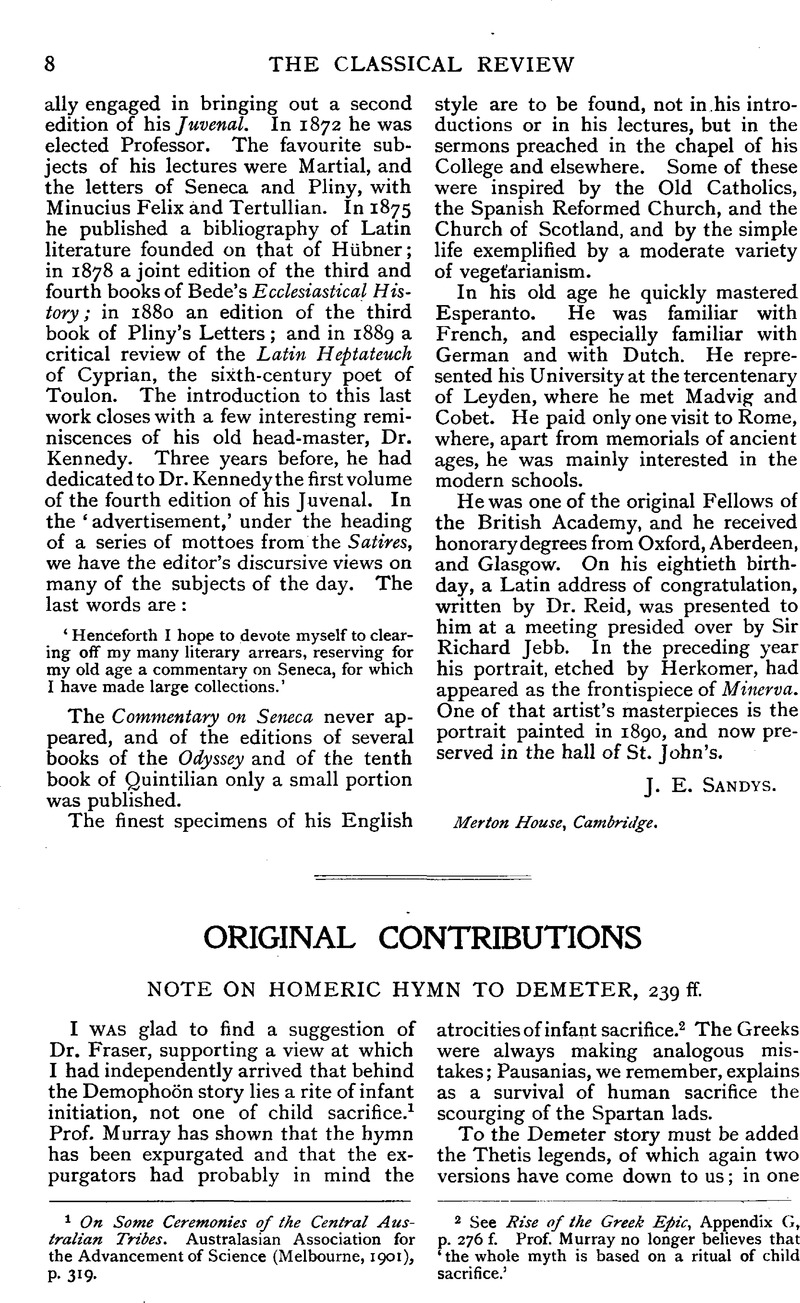No CrossRef data available.
Published online by Cambridge University Press: 27 October 2009

page 8 note 1 On Some Ceremonies of the Central Australian Tribes. Australasian Association for the Advancement of Science (Melbourne, 1901), p. 319.Google Scholar
page 8 note 2 See Rise of the Greek Epic, Appendix G, p. 276 f.Google Scholar Prof. Murray no longer believes that ‘the whole myth is based on a ritual of child sacrifice.’
page 9 note 1 The ankle motive appears also in the fire story, Ptol. Chenn. Nov. Hist. vi. p. 152B–195W quoted PfisterGoogle Scholar, Der Reliquien Kult, p. 322.
page 9 note 2 Hollis, , The Naudi, p. 99.Google Scholar
page 9 note 3 Eumelos quoted by Pausanias, II. 3. 11. Probably the story refers to the definite practice of exposing infants in temples; cf. the case of Kassandra and Helenos. The use of the word κατακρυπτειν is perhaps almost technical.
page 9 note 4 Schol. Pind. Ol. xiii. 74.
page 9 note 5 Dalzell, , The Darker Superstitions of Scotland, p. 176.Google Scholar
page 9 note 6 Brown, Miss in Folklore, xxi. p. 226Google Scholar; Henderson, , Folklore of the Northern Counties, p. 20Google Scholar. Cf. the warming-pan at Whitby (County Folklore, ii., ‘The North Riding,’ Mrs. Gutch, p. 284).
page 9 note 7 Duncan, , ‘Further Notes from County Leitrim,’ Folklore, v. pp. 186 187.Google Scholar
page 9 note 8 Henderson, op. cit. pp. 21–22.
page 9 note 9 Bois, Du, The Religion of the Luisêno Indians (University of California publications in American Archaeology and Ethnology, vol. 8, No. 3, p. 94).Google Scholar For the acquisition of ‘Zauberkraft’ as the motive in puberty tortures, see Preuss in Globus 87, p. 415.
page 9 note 10 Du Bois, op. cit. p. 150.
page 10 note 1 See examples, Henderson, op. cit. p. 15.
page 10 note 2 Hesiod, , Theog. 346–348.Google Scholar
page 10 note 3 Pausanias, viii. 41. 3, i. 37. 3; Homer, Iliad, xxiii. 140; Schol. A and B, Iliad, xxiii. 142.
page 10 note 4 Skeat, , Malay Magic, pp. 342, 355.Google Scholar
page 10 note 5 Roscoe, , J.A.I. xxxix. p. 189.Google Scholar
page 10 note 6 Pausanias, 38. 9; iv. 33. 1, viii. 16. I, viii. 8. 2; Plutarch, Lys. 28; Euripides, Bacchae, 521.
page 10 note 7 Paus. i. 34. 4.
page 10 note 8 See Miss Harrison on the Kouretes and Zeus Kouros, B.S.A. xv. p. 324 foll.
page 10 note 9 Preuss, , Zeitschrift für Erdkunde, 1905, p. 434.Google Scholar
page 10 note 10 Skeat, , Malay Magic, pp. 342, 343.Google Scholar
page 10 note 11 Scott, , Minstrelsy of the Scottish Border, vol. ii. pp. 318, 319Google Scholar. Cf. another example in Moore, , Folklore, v. p. 223.Google Scholar
page 10 note 12 Plutarch, Vit. Ly. cxvi., trans. Langhorne.
page 10 note 13 Sir T. Browne, ‘A Letter to a Friend upon occasion of the Death of his Intimate Friend.’
page 10 note 14 Folklore, xxi. p. 147 foll.Google Scholar
page 11 note 1 For Callicantzari in Chios see Lawson, , Modern Greek Folklore and Ancient Greek Religion, p. 208.Google Scholar
page 11 note 2 Fraser, , Adonis, Attis, and Osiris, p. 146ff.Google Scholar
page 11 note 3 Iamblichos de Mysteriis, v. 12, trans. Frazer, loc. cit. Cf. use of fire in purification. Melampos purified the Proitids ![]() . Diphil. ap Clem. Alex. Strom, vii. 26. 844.
. Diphil. ap Clem. Alex. Strom, vii. 26. 844.
page 11 note 4 Ovid, Met. xiv. 600.